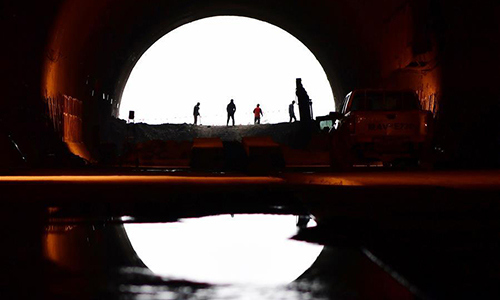 (File photo/Xinhua) New tech adopted to blast tunnel 102 meters under the Great Wall The world-famous Badaling Great Wall in northern Beijing will meet a 350-kilometer-an-hour super railway more than 100 meters underground. The Beijing-Zhangjiakou High-Speed Railway, linking the two co-hosting cities of the 2022 Winter Olympics, is building a tunnel under the Great Wall. It took Chinese engineers months to choreograph the best intersection point. In the end, a 12-kilometer-long tunnel, deep below the Badaling Great Wall, passed experts' appraisal, the People's Daily reported Monday. The depth of the tunnel will range from four meters to 432 meters. Now, people are holding their breath on the completion of the tunnel while ensuring that the Great Wall is not damaged in the process. Luo Duhao, chief engineer of the Beijing-Zhangjiakou High-Speed Railway Line, being built by China Railway No. 5 Engineering Group Co., told the Global Times they employ "precision micro-blasting" technology, which has a velocity of 0.2 centimeters per second and is able to make the tremor weaker than the traditional firepower blasts that have a velocity of 5 centimeters per second. Luo said that the new technology will ensure that the Great Wall won't be affected by the blasts, as they will be barely felt. Moreover, the new technology causes little damage to the geological environment, which will help protect the Great Wall, Dai Longzhen, deputy manager of the Beijing-Zhangjiakou High-Speed Railway Line, told the Global Times. "I myself once stood on the Great Wall and I could not feel the blast at all," Dai added. Zhang Xuehua, a blast expert at the construction site, told the People's Daily that the construction of the tunnel has completed 4,500 blasts since early February this year. Apart from protecting the Great Wall, the construction of the new railway also needs to take into account the preservation of the old Beijing-Zhangjiakou railway, which was completed in 1909 under the supervision of Zhan Tianyou, a well-known railway engineer, marking China's first independently designed, built and operated railway. Wang Mengshu from the China Academy of Engineering suggested in March that a park be built to protect the old railway because it will be discarded as soon as the new railway is completed, news site thepaper.cn reported. "The old railway won't be demolished as it is of great historic value. In addition, we will strive to protect it during construction," said Dai. A 40-meter-long section of the tunnel will pass underneath the Qinglongqiao station of the old railway. Luo said the construction team has opted not to use any explosives during the construction of that section of the tunnel for fear that blasts might damage the old railway. Record-breaking depth In the middle of the tunnel, workers will build a spacious and well-decorated station right under the Great Wall, with a record-breaking construction space of 36,000 square meters, the Xinhua News Agency reported. The station will be 102 meters below the surface of the Badaling Great Wall. Dai said the construction area and the depth of the station is "record-breaking." He said that because the station is built underground, it will cause less damage to the plantation, and it also demonstrates China's top-notch railway construction capabilities. Originating from the Beijing Railway Station North, the Beijing-Zhangjiakou High-Speed Railway Line runs through Haidian, Changping and Yanqing districts of Beijing. The line continues northwest through Huailai and Xunhua counties in Hebei Province before terminating in the city of Zhangjiakou, making for a total length of 174 kilometers. The line is designed for trains traveling up to 350 kilometers per hour, which is expected to shorten the single-journey time from more than 3 hours to approximately 1 hour. The line is estimated to be completed in 2019. |